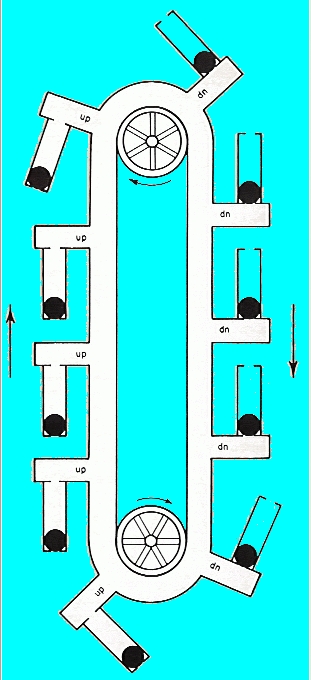Buoyant bellows engines
The history of perpetual motion machines is a fascinating example of perpetual recycling of wrong ideas. This is nicely illustrated by an engine that I call the "bucket brigade".
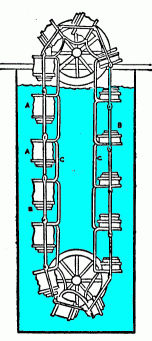
|  |
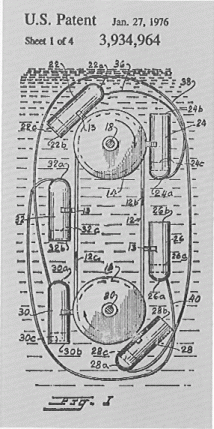 |
|
Br. Patent 1330 Granted in 1857. Dircks (1861) p. 478 |
Clearer drawing by James De Ath used with permission. |
David Diamond US Patent 3,934,964 Jan 17, 1976 |
|---|
The history of an unworkable idea.
The first figure was patented in the name of the inventor's agent Peter Armand le Comte de Fontainemoreau of London, who describes it:
The apparatus is composed of a number of hollow elastic buckets or bellows, partly immersed in water, made to pass over two pulleys. Each bellows is furnished with leaden weights at the bottom, which forces the air contained in the bellows on one side, to pass by means of connecting tubes into those buckets or bellows which are on the opposite side. The bellows are fitted to slotted links, and connected together so as to form an endless chain, which passes over the two pulleys.The second picture shows the connecting tubes more clearly.
The third picture is the very same device, patented in the USA by David Diamond, which somehow slipped by the patent examiners while they were asleep. He called it a "gravity-actuated fluid displacement power generator."
This idea likely evolved from a simpler versions, which are still seen today. Albert van Driel's drawing below shows a version with the liquid inside and no liquid outside. The principle is the same whether liquid is outside or inside the pistons, or both. The second drawing below shows the principle illustrated with just two of the pistons.
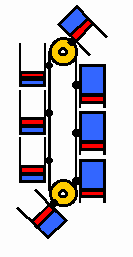 |
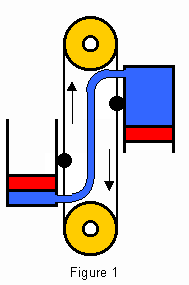 |
| Albert van Driel's puzzles | |
|---|---|
How it's supposed to work.
Let's look at the first version, the left figure. One one side of the axles the lead weights compress the air inside the bellows, making the enclosed volume smaller. On the other side the weights enlarge the volume of the bellows, so the buoyant force is greater. The principle is that of Archimedes: "The buoyant force on an immersed body is equal to the weight of the water it displaces."Sounds pretty reasonable? So why won't it work? Do the cross-linking tubes of the second version help the situation?
|
Martin Gardner spoofed this idea, with his own version called the "dynaforce generator". It, like the others, operates underwater. The heavy balls in the cylinders move without friction, and seal perfectly. The hollow belt is air-filled. Gardner attributed this invention to his fictional creation Dr. Joshua Matrix, in the February 1972 issue of Scientific American As an additional joke, he added the labels up and dn which are inversions of each other in a sans-serif font face. Supposedly this gave the device extra impetus. Rather than the clumsy tubes (which might get twisted or tangled), Gardner used a flexible hollow belt to communicate air from one side to the other. It has sliding balls in the tubes (with leakproof seals), it has buoyancy on the left and the extra weight of water in the tubes on the right, all supposedly and magically contributing to the continual clockwise motion indicated by the four arrows. Even the arrows might help.
Note that this joke appeared in 1972, four years before David Diamond was granted a patent on the same idea. Diamond could have saved himself the filing fee.
This version reveals clues that help you find one flaw in David Diamond's version with flexible air lines.
The original drawing wasn't in color. Previously published colorized versions not only had an ugly brown color, but they neglected to color the fluid in the tubes on the right. Having confirmed this with Martin, I have re-colored it to show the fluid properly, and in a more pleasing aqua color.
Answer and discussion.
Re: Answers left as exercise for the student. Send your answers to Donald Simanek at the address shown above. The earliest good one(s) that arrive may be posted here, with credit to author. I will post (at my discretion) answers that are in simple to explain, clear, correct, perceptive, and which stimulate thinking and further discussion. Posted answers, whether written by me or by others, do not always represent the final word on a given proposal. On several occasions perceptive readers have noticed things we missed, or suggested simpler ways to explain something. So don't hesitate to skeptically rethink given "answers".
While I welcome submission of new or innovative perpetual motion puzzles, I assume no obligation to respond in detail to all of them. In particular, I cannot be expected to analyze vague proposals, overly and unncecssarily complicated designs, nor ideas that are simply variations of classics found in the literature. I've already received proposals that fail for the same reasons already discussed above, indicating that the person proposing the idea hadn't fully understood these pages. Also, I choose not to include devices that would require advanced mathematics or physics for detailed analysis. I don't like to post puzzles unless I am reasonably confident what the flaw is, and that the flaw can be explained using elementary physics principles.
Return to top.
Return to the Museum's main gallery.
Return to Donald Simanek's front page.
